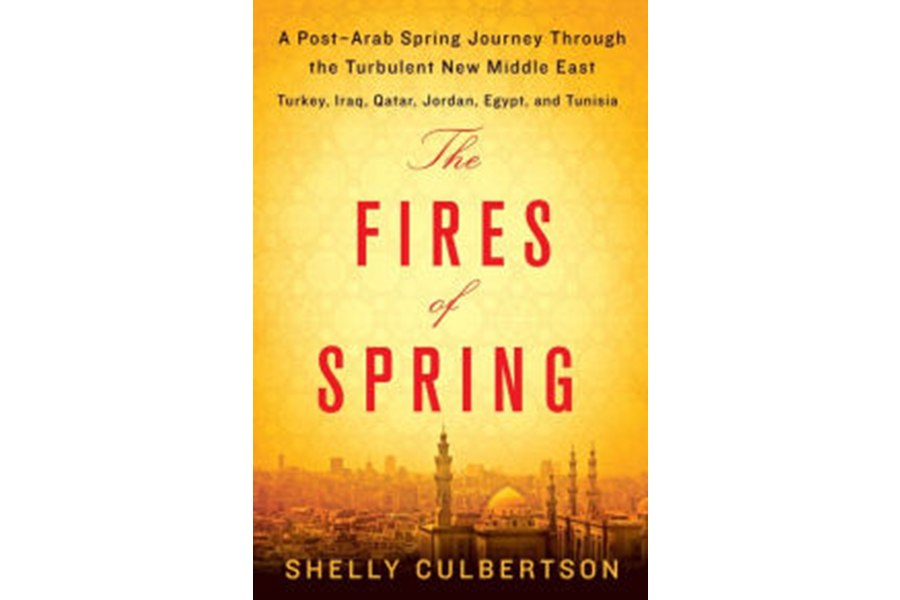'The Fires of Spring' tries to make sense of Arab Spring
Loading...
“So what’s the deal with the Middle East?” comedian Jerry Seinfeld might well ask – as would anyone else for that matter. While hardly fertile ground for humor, that part of the world does seem to be infinitely confounding.
Since the eruption of the so-called Arab Spring in 2011, sparked by the self-immolation of a Tunisian fruit vendor, the region has been convulsed by protests, regime changes, civil wars, violence, and terrorism.
With 35,000 US troops deployed in 20 nations in and around the region, Americans have a particularly strong incentive for trying to make sense of the Middle East. In The Fires of Spring, Shelly Culbertson tackles this tall order.
Subtitled A Post-Arab-Spring Journey Through the Turbulent New Middle East – Tunisia, Turkey, Iraq, Jordon, Qatar, Egypt, her first book is an engaging meander that weaves history, culture, politics, and economics into a cohesive narrative. It is part travelogue, part political primer. The description of camel races in Qatar, as an example, provides an entertaining interlude from political reportage.
A veteran Middle East hand – with 15 years experience working there for the RAND Corporation and the US State Department – Culbertson spent nearly a year taking the pulse of the six nations she profiles. Beginning in June 2014 she visited places of historical and contemporary interest and interviewed activists, government officials, poets, bloggers, business people, and cabdrivers.
She relentlessly presses her subjects about what has happened since 2011, why, and where it is all heading. The reader comes away with a sense not only of what went wrong, but also what has gone right, along with an appreciation for the diversity of the region and its people.
The author starts where it all began, in Tunisia, which has weathered the turbulence of the Arab Spring better than most. Like the other five nations in the book, Tunisia once was part of the Ottoman Empire and later was ruled by a western colonial power. Independence ushered in a harsh military autocracy there, as it did throughout the region. For 55 years, from 1956 to 2011, Tunisia was led by just two men: the second of whom, Ben Ali, fled in the face of an enflamed citizenry.
The transition away from dictatorship in Tunisia has involved considerable compromise, which, it is worth noting in these partisan times, is the lifeblood of democracy. Islamists, secularists, men and woman – among other interested parties – together forged a new constitution that, after considerable wrangling, omits any reference to “sharia law” and proclaims the equality of the sexes.
Indeed, Culbertson points out that Tunisia now boasts a higher percentage of women in its National Assembly (31 percent) than there is in the US Congress (19 percent). And, not surprisingly, the president of Tunisia is now subject to two five-year terms.
For all that, the nation has great challenges ahead. Unemployment and prices are up since 2011, and two terrorist attacks aimed at foreign tourists have damaged the economy. Some 3,000 Tunisian citizens have left the country to join ISIS, the author reports. But the hope remains that common sense will continue to have the upper hand. Meherzia Labidi, one of the drafters of the new constitution, tells the author what her mantra was during that process: “Let’s try to reconcile Islam and democracy and Islam and human rights. Let’s tell people that we are not doomed to despotism or to chaos.”
Further proof of the diversity of the Middle East is the tiny energy-rich nation of Qatar, which enjoys the highest per capita GDP in the world, $140,000, and is home to Al Jazeera. Its economy is so robust that foreign workers are imported in wholesale lots: Qataris now make up just 13 percent of the population of their own country. The poor treatment of these workers has become an international issue, particularly with Qatar being the host for the 2022 World Cup in soccer.
Like Jordon, Qatar has experienced what can only be called Arab Spring lite. Rulers of those two nations have survived by showering their subjects with government largess and instituting incremental changes. Their respective economies are stronger than their neighbors, allowing them to afford this strategy. But both nations also benefited from observing the turmoil in Egypt, Iraq and Libya, and deciding not to follow that partisan path.
How Egypt, the most populous nation in the region with 92 million citizens, emerges from its Arab Spring will in large measure determine if the changes that have roiled the Middle East turn out to be positive or negative for the region. Egyptians have learned the hard way that simply deposing a dictator does not guarantee a bright and shinning future.
Brave citizens have suffered and died there only to see one strong man replaced by a would-be Islamist autocrat –and he, in turn, replaced by yet another tyrant. Many view the current president and former army field marshal, Abdel Fatah al-Sisi, as a less benign version of his two predecessors.
The author makes clear that for all that, Egypt’s biggest problems are economic. One in five Egyptians live in slums; nearly a million people have taken up residence in a sprawling Cairo cemetery. Poverty has increased since 2011, and tourism is way down, by as much as 95 percent, according to one report.
But unlike many of its neighbors, such as Iraq and Syria, it can’t blame western colonials for creating its polity out of whole cloth following World War I. Egypt has been Egypt for millennia. Culbertson sums up its decline succinctly in describing Cairo, once considered the Paris of the Nile: “Cairo was once a city of grandeur and color.... [it is] now a city the color of dirt.” She adds, “Egypt is a country of squandered wealth, sophistication, and heritage. Arab Spring was about seeking something different.”
Whether Egyptians and their neighbors find it will not be known for years, or perhaps even decades.








